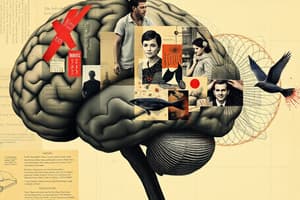Podcast
Questions and Answers
Which statement accurately reflects the role of sensory receptors in motor control?
Which statement accurately reflects the role of sensory receptors in motor control?
- They primarily function to inhibit reflexes to allow for more complex voluntary movements.
- They gather information from the environment and the body, influencing motor actions. (correct)
- They provide the initial 'blueprint' for movement, which is then executed without modification.
- They initiate motor commands directly, bypassing the need for central processing.
Which of the following components of motor control involves the harmonious interaction of multiple muscles to produce coordinated movement?
Which of the following components of motor control involves the harmonious interaction of multiple muscles to produce coordinated movement?
- Adaptability
- Volition
- Coordination (correct)
- Proprioception
What role does the association cortex play in the hierarchy of motor control?
What role does the association cortex play in the hierarchy of motor control?
- Orchestrating voluntary movement.
- Crafting purpose and sequence of movements. (correct)
- Guiding rhythm and posture.
- Executing primitive motor patterns.
The size principle states that motor units are recruited in order based on what?
The size principle states that motor units are recruited in order based on what?
What is the function of gamma motor neurons?
What is the function of gamma motor neurons?
Which of the following describes the role of the spinal cord in motor control?
Which of the following describes the role of the spinal cord in motor control?
What is the main difference between Group Ia and Group II afferent fibers in muscle spindles?
What is the main difference between Group Ia and Group II afferent fibers in muscle spindles?
What is the role of the basal ganglia and cerebellum in motor control?
What is the role of the basal ganglia and cerebellum in motor control?
Which of the following describes the 'final common pathway' in motor control?
Which of the following describes the 'final common pathway' in motor control?
What is the primary function of the Golgi Tendon Organ (GTO)?
What is the primary function of the Golgi Tendon Organ (GTO)?
What is the role of the motor cortex in the hierarchy of control?
What is the role of the motor cortex in the hierarchy of control?
Sensory input is the foundation for motor control. What is the consequence of lacking sensation?
Sensory input is the foundation for motor control. What is the consequence of lacking sensation?
During a muscle contraction, what happens to the muscle spindle if there is no gamma motor neuron input?
During a muscle contraction, what happens to the muscle spindle if there is no gamma motor neuron input?
Which is NOT part of the definition of motor control?
Which is NOT part of the definition of motor control?
What are the signs of lower motor neuron disorders?
What are the signs of lower motor neuron disorders?
Proprioception is an essential component of motor control. What does it refer to?
Proprioception is an essential component of motor control. What does it refer to?
What does a muscle unit consist of?
What does a muscle unit consist of?
Rate coding is one mechanism of muscle contraction. What does it refer to?
Rate coding is one mechanism of muscle contraction. What does it refer to?
How are motor units recruited?
How are motor units recruited?
What is the difference between fused and unfused tetanus?
What is the difference between fused and unfused tetanus?
What is the functional consequence of the 'all or none' principle in the context of motor units?
What is the functional consequence of the 'all or none' principle in the context of motor units?
How does Amyotrophic Lateral Sclerosis (ALS) affect motor unit function, leading to muscle weakness?
How does Amyotrophic Lateral Sclerosis (ALS) affect motor unit function, leading to muscle weakness?
Why are Type I (slow-twitch) motor units advantageous for endurance activities like long-distance running?
Why are Type I (slow-twitch) motor units advantageous for endurance activities like long-distance running?
How would the motor unit composition change to perform a 1 rep max lift, according to the size principle?
How would the motor unit composition change to perform a 1 rep max lift, according to the size principle?
During voluntary movements, how are muscles primarily stimulated, with respect to twitch, unfused tetanus and fused tetanus?
During voluntary movements, how are muscles primarily stimulated, with respect to twitch, unfused tetanus and fused tetanus?
What potential risk is associated with reduced Golgi Tendon Organ (GTO) function due to Peripheral Neuropathy?
What potential risk is associated with reduced Golgi Tendon Organ (GTO) function due to Peripheral Neuropathy?
What best describes the roles of intrafusal and extrafusal muscle fibers?
What best describes the roles of intrafusal and extrafusal muscle fibers?
What is the consequence of the absence of alpha-gamma coactivation?
What is the consequence of the absence of alpha-gamma coactivation?
What distinguishes a motor unit from a single muscle fiber?
What distinguishes a motor unit from a single muscle fiber?
Which of the following describes the progression of motor unit recruitment during a gradual increase in muscle force, according to the size principle?
Which of the following describes the progression of motor unit recruitment during a gradual increase in muscle force, according to the size principle?
If someone is experiencing difficulty controlling the amount of force they exert and is having uncoordinated movements, which sensory organ may be impaired?
If someone is experiencing difficulty controlling the amount of force they exert and is having uncoordinated movements, which sensory organ may be impaired?
Which of the following does NOT occur as we age concerning the three motor unit types?
Which of the following does NOT occur as we age concerning the three motor unit types?
What part of the spinal cord do alpha motor neurons project from?
What part of the spinal cord do alpha motor neurons project from?
What would happen if a long-distance runner's Type I muscle fibers started behaving like Type IIx muscle fibers?
What would happen if a long-distance runner's Type I muscle fibers started behaving like Type IIx muscle fibers?
What occurs if Peripheral Neuropathy affects the Golgi Tendon Organ?
What occurs if Peripheral Neuropathy affects the Golgi Tendon Organ?
What fibers are responsible for generating actual muscle force?
What fibers are responsible for generating actual muscle force?
Why is alpha-gamma coactivation important?
Why is alpha-gamma coactivation important?
What type of stimulus might cause a muscle to demonstrate unfused tetanus?
What type of stimulus might cause a muscle to demonstrate unfused tetanus?
What part of the spinal cord do sensory neurons project from?
What part of the spinal cord do sensory neurons project from?
What is a potential side effect of ALS concerning a motor unit?
What is a potential side effect of ALS concerning a motor unit?
Flashcards
Volition
Volition
The mind's intent flowing into muscular deed.
Coordination
Coordination
Muscles uniting in harmonious orchestration.
Proprioception
Proprioception
Inner sight of limb and length, informed by sensors within.
Postural Adjustments
Postural Adjustments
Signup and view all the flashcards
Sensory Feedback
Sensory Feedback
Signup and view all the flashcards
Physical Compensation
Physical Compensation
Signup and view all the flashcards
Unconscious Processing
Unconscious Processing
Signup and view all the flashcards
Adaptability
Adaptability
Signup and view all the flashcards
Functional Segregation
Functional Segregation
Signup and view all the flashcards
Spinal Cord (in motor control)
Spinal Cord (in motor control)
Signup and view all the flashcards
Brainstem (in motor control)
Brainstem (in motor control)
Signup and view all the flashcards
Motor Cortex
Motor Cortex
Signup and view all the flashcards
Association Cortex
Association Cortex
Signup and view all the flashcards
Basal Ganglia & Cerebellum
Basal Ganglia & Cerebellum
Signup and view all the flashcards
Motor Unit
Motor Unit
Signup and view all the flashcards
Motor Pool
Motor Pool
Signup and view all the flashcards
Size Principle
Size Principle
Signup and view all the flashcards
Muscle Spindles
Muscle Spindles
Signup and view all the flashcards
The Stretch Reflex
The Stretch Reflex
Signup and view all the flashcards
Golgi Tendon Organ (GTO)
Golgi Tendon Organ (GTO)
Signup and view all the flashcards
Ventral Side
Ventral Side
Signup and view all the flashcards
Alpha Motor Neurons
Alpha Motor Neurons
Signup and view all the flashcards
Sensory Neurons (Afferent)
Sensory Neurons (Afferent)
Signup and view all the flashcards
All or None Response
All or None Response
Signup and view all the flashcards
Amyotrophic Lateral Sclerosis (ALS)
Amyotrophic Lateral Sclerosis (ALS)
Signup and view all the flashcards
Type I Motor Units
Type I Motor Units
Signup and view all the flashcards
Type IIa Motor Units
Type IIa Motor Units
Signup and view all the flashcards
Type IIx Motor Units
Type IIx Motor Units
Signup and view all the flashcards
Twitch
Twitch
Signup and view all the flashcards
Unfused Tetanus
Unfused Tetanus
Signup and view all the flashcards
Fused Tetanus
Fused Tetanus
Signup and view all the flashcards
Peripheral Neuropathy
Peripheral Neuropathy
Signup and view all the flashcards
Intrafusal Fibers
Intrafusal Fibers
Signup and view all the flashcards
Extrafusal Fibers
Extrafusal Fibers
Signup and view all the flashcards
Alpha-Gamma Coactivation
Alpha-Gamma Coactivation
Signup and view all the flashcards
Study Notes
Spinal Cord Illustration
- The dorsal side is the back of the spinal cord
- The ventral side is the front of the spinal cord
- Alpha motor neurons are efferent neurons
- Sensory neurons are afferent neurons
Motor Units and "All or None" Response
- A motor unit consists of one alpha motor neuron plus all the muscle fibers it innervates
- "All or none" indicates that when a motor neuron fires, all muscle fibers in its motor unit contract fully, never partially
Disorder Influencing Motor Units
- Amyotrophic Lateral Sclerosis (ALS) affects motor neurons, leading to their degeneration
- As motor units die due to ALS, muscle control weakens
- ALS results in loss of strength and movement
Motor Unit Types
- Type I (slow-twitch) motor units generate low force and are very fatigue-resistant
- Type IIa (fast fatigue-resistant) motor units produce medium force and have moderate fatigue resistance
- Type IIx (fast fatigable) motor units generate high force but fatigue quickly
- Long-distance runners benefit from having more Type I motor units for endurance
- Aging leads to a quicker loss of Type IIx motor units, impairing explosive movements
Size Principle
- Smaller motor units are recruited prior to larger ones
- The size principle leads to smoother, more energy-efficient movement
- During a 1 rep max, all motor units, including large and fast-fatigable ones, are recruited
Types of Muscle Response
- Twitch refers to a single, brief contraction
- Unfused tetanus involves repeated stimuli without fully sustained contraction
- Fused tetanus involves a rapid, continuous contraction with no relaxation
- Unfused tetanus is the most common type during voluntary movements
Golgi Tendon Organ (GTO) Disorder
- Peripheral Neuropathy diminishes GTO function
- Without proper GTO feedback, the body cannot detect excessive force, resulting in a risk of injury and uncoordinated movement
Muscle Spindle Sensitivity and Fiber Types
- Muscle spindles are sensitive to stretch
- Intrafusal fibers inside spindles detect stretch
- Extrafusal fibers generate actual muscle force
Alpha-Gamma Coactivation
- During muscle contraction, both alpha and gamma motor neurons fire
- Gamma motor neuron firing maintains taut muscle spindles
- Without alpha-gamma coactivation, stretch sensitivity is diminished
- This harms movement control since spindles go slack during contraction
Studying That Suits You
Use AI to generate personalized quizzes and flashcards to suit your learning preferences.




